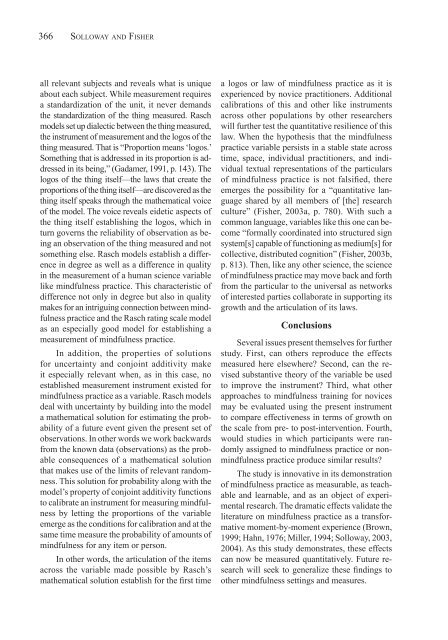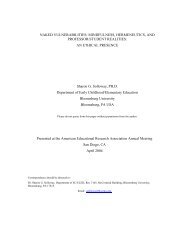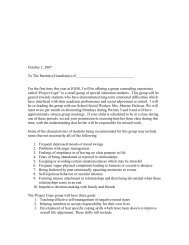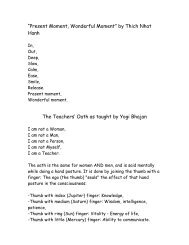Mindfulness Practice: A Rasch Variable Construct Innovation
Mindfulness Practice: A Rasch Variable Construct Innovation
Mindfulness Practice: A Rasch Variable Construct Innovation
You also want an ePaper? Increase the reach of your titles
YUMPU automatically turns print PDFs into web optimized ePapers that Google loves.
366 So l l o way a n d Fi s h e rall relevant subjects and reveals what is uniqueabout each subject. While measurement requiresa standardization of the unit, it never demandsthe standardization of the thing measured. <strong>Rasch</strong>models set up dialectic between the thing measured,the instrument of measurement and the logos of thething measured. That is “Proportion means ‘logos.’Something that is addressed in its proportion is addressedin its being,” (Gadamer, 1991, p. 143). Thelogos of the thing itself—the laws that create theproportions of the thing itself—are discovered as thething itself speaks through the mathematical voiceof the model. The voice reveals eidetic aspects ofthe thing itself establishing the logos, which inturn governs the reliability of observation as beingan observation of the thing measured and notsomething else. <strong>Rasch</strong> models establish a differencein degree as well as a difference in qualityin the measurement of a human science variablelike mindfulness practice. This characteristic ofdifference not only in degree but also in qualitymakes for an intriguing connection between mindfulnesspractice and the <strong>Rasch</strong> rating scale modelas an especially good model for establishing ameasurement of mindfulness practice.In addition, the properties of solutionsfor uncertainty and conjoint additivity makeit especially relevant when, as in this case, noestablished measurement instrument existed formindfulness practice as a variable. <strong>Rasch</strong> modelsdeal with uncertainty by building into the modela mathematical solution for estimating the probabilityof a future event given the present set ofobservations. In other words we work backwardsfrom the known data (observations) as the probableconsequences of a mathematical solutionthat makes use of the limits of relevant randomness.This solution for probability along with themodel’s property of conjoint additivity functionsto calibrate an instrument for measuring mindfulnessby letting the proportions of the variableemerge as the conditions for calibration and at thesame time measure the probability of amounts ofmindfulness for any item or person.In other words, the articulation of the itemsacross the variable made possible by <strong>Rasch</strong>’smathematical solution establish for the first timea logos or law of mindfulness practice as it isexperienced by novice practitioners. Additionalcalibrations of this and other like instrumentsacross other populations by other researcherswill further test the quantitative resilience of thislaw. When the hypothesis that the mindfulnesspractice variable persists in a stable state acrosstime, space, individual practitioners, and individualtextual representations of the particularsof mindfulness practice is not falsified, thereemerges the possibility for a “quantitative languageshared by all members of [the] researchculture” (Fisher, 2003a, p. 780). With such acommon language, variables like this one can become“formally coordinated into structured signsystem[s] capable of functioning as medium[s] forcollective, distributed cognition” (Fisher, 2003b,p. 813). Then, like any other science, the scienceof mindfulness practice may move back and forthfrom the particular to the universal as networksof interested parties collaborate in supporting itsgrowth and the articulation of its laws.ConclusionsSeveral issues present themselves for furtherstudy. First, can others reproduce the effectsmeasured here elsewhere? Second, can the revisedsubstantive theory of the variable be usedto improve the instrument? Third, what otherapproaches to mindfulness training for novicesmay be evaluated using the present instrumentto compare effectiveness in terms of growth onthe scale from pre- to post-intervention. Fourth,would studies in which participants were randomlyassigned to mindfulness practice or nonmindfulnesspractice produce similar results?The study is innovative in its demonstrationof mindfulness practice as measurable, as teachableand learnable, and as an object of experimentalresearch. The dramatic effects validate theliterature on mindfulness practice as a transformativemoment-by-moment experience (Brown,1999; Hahn, 1976; Miller, 1994; Solloway, 2003,2004). As this study demonstrates, these effectscan now be measured quantitatively. Future researchwill seek to generalize these findings toother mindfulness settings and measures.






